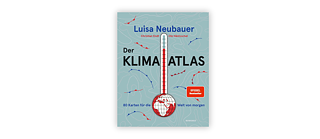A book that explains the climate crisis in pictures, without a lot of text and a jumble of figures? Together with journalist Christian Endt and graphic designer Ole Häntzschel, activist Luisa Neubauer has achieved just that. They present facts about the climate crisis in 80 information graphics - presented in an easy-to-understand manner.
You know that Fridays for Future activist Luisa Neubauer is an ace communicator when you hear her in live debates. Whether she is skilfully parrying CDU party chairman Friedrich Merz with statements such as, "Perhaps we can first classify the whole thing scientifically", or asking Markus Blume, the Bavarian Minister for Science and Art and CSU member, with a smile on her lips: "Do you or should I tell people how many wind turbines were approved in Bavaria in the first half of the year?" - it quickly becomes clear: you can't win a debate against Neubauer without making an effort. She usually backs up her arguments with figures and has a study ready for what feels like every statement made by her opponents, against which she measures what her competitors have said. With concentrated verbal power, she lets the facts speak for themselves and manages to convey science in a way that even those who hate numbers can follow well.Together with data journalist Christian Endt and graphic designer Ole Häntzschel, Luisa Neubauer has now transferred this educational aspect into her new book, the Klima-Atlas (Climate Atlas). The three of them have created an atlas that uses information graphics to convey knowledge about the climate crisis. Eight chapters and 80 maps deal with geography, ecology, health, society, politics, the economy and technology, after the first chapter provides an overview of the current "state of the planet".

Hockey sticks in a different way
“How do you describe something that people have never experienced before?” ask the authors right at the beginning of the book. And then show how it has been snowing less and less around Christmas since 1950 or that the cherry trees in Kyoto are blooming earlier and earlier.As a third map, Neubauer, Endt and Häntzschel looked at the frequently quoted hockey stick diagram - a diagram that normally shows an almost flat temperature curve for many centuries, but which rises steeply at the end like the blade of a hockey stick.
However, the three authors have not depicted the rise in temperature in the climate atlas, but rather the CO2 concentration in the atmosphere in combination with important climate changes. The impressive message of the graphic: Over the last 10,000 years, none of the supposedly major climate events have changed the CO2 concentration as much as the fossil inventions of the last 300 years.
About deep-frozen pizzas and wind turbines
In addition to such rather dystopian graphics, the climate atlas also presents solutions and future scenarios. And it never ceases to surprise. After all, who knew how many frozen pizzas could be baked with the power generated by a single rotation of a wind turbine - it's ten pizzas. Also worth knowing: local bird populations are shrinking by 15 per cent due to oil and gas extraction, while wind turbines do not appear to have any measurable negative effect on the population.In true climate activism style, the book also shows ways in which the climate can be protected, what forms of offline and online activism there are, and how much the behaviour of individuals can affect the environment. Luisa Neubauer, Christian Endt and Ole Häntzschel have succeeded in creating a book that conveys abstract knowledge in a relatively uncomplicated way. The only criticism: the light blue font on a white background in the introductory texts of the individual chapters is not barrier-free.
So if, like Neubauer, you want to enter into a discussion about the climate crisis armed for the next time, the Climate Atlas definitely offers you a solid foundation. With convincing facts!
Luisa Neubauer, Ole Häntzschel, Christian Endt: Der Klima-Atlas. Non-fiction book.
Hamburg: Rowohlt Buchverlag, 2024. 192 p.
ISBN: 978-3-498-00705-8
Hamburg: Rowohlt Buchverlag, 2024. 192 p.
ISBN: 978-3-498-00705-8
October 2024




